Is Kefir Keto-Friendly?
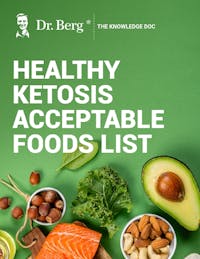
Healthy Keto Acceptable Foods List
Explore a comprehensive list of foods and beverages that align with Healthy Keto®
Identify which foods support fat-burning and metabolic health
Discover nutritious options for fats, proteins, and vegetables to support your health goals
Learn about common foods that aren’t Healthy Keto-approved

Healthy Keto Acceptable Foods List
Explore a comprehensive list of foods and beverages that align with Healthy Keto®
Identify which foods support fat-burning and metabolic health
Discover nutritious options for fats, proteins, and vegetables to support your health goals
Learn about common foods that aren’t Healthy Keto-approved

Healthy Keto Acceptable Foods List
Explore a comprehensive list of foods and beverages that align with Healthy Keto®
Identify which foods support fat-burning and metabolic health
Discover nutritious options for fats, proteins, and vegetables to support your health goals
Learn about common foods that aren’t Healthy Keto-approved

Healthy Keto Acceptable Foods List
Explore a comprehensive list of foods and beverages that align with Healthy Keto®
Identify which foods support fat-burning and metabolic health
Discover nutritious options for fats, proteins, and vegetables to support your health goals
Learn about common foods that aren’t Healthy Keto-approved

Healthy Keto Acceptable Foods List
Explore a comprehensive list of foods and beverages that align with Healthy Keto®
Identify which foods support fat-burning and metabolic health
Discover nutritious options for fats, proteins, and vegetables to support your health goals
Learn about common foods that aren’t Healthy Keto-approved

Healthy Keto Acceptable Foods List
Explore a comprehensive list of foods and beverages that align with Healthy Keto®
Identify which foods support fat-burning and metabolic health
Discover nutritious options for fats, proteins, and vegetables to support your health goals
Learn about common foods that aren’t Healthy Keto-approved

Healthy Keto Acceptable Foods List
Explore a comprehensive list of foods and beverages that align with Healthy Keto®
Identify which foods support fat-burning and metabolic health
Discover nutritious options for fats, proteins, and vegetables to support your health goals
Learn about common foods that aren’t Healthy Keto-approved

Healthy Keto Acceptable Foods List
Explore a comprehensive list of foods and beverages that align with Healthy Keto®
Identify which foods support fat-burning and metabolic health
Discover nutritious options for fats, proteins, and vegetables to support your health goals
Learn about common foods that aren’t Healthy Keto-approved

Healthy Keto Acceptable Foods List
Explore a comprehensive list of foods and beverages that align with Healthy Keto®
Identify which foods support fat-burning and metabolic health
Discover nutritious options for fats, proteins, and vegetables to support your health goals
Learn about common foods that aren’t Healthy Keto-approved

Healthy Keto Acceptable Foods List
Explore a comprehensive list of foods and beverages that align with Healthy Keto®
Identify which foods support fat-burning and metabolic health
Discover nutritious options for fats, proteins, and vegetables to support your health goals
Learn about common foods that aren’t Healthy Keto-approved

Healthy Keto Acceptable Foods List
Explore a comprehensive list of foods and beverages that align with Healthy Keto®
Identify which foods support fat-burning and metabolic health
Discover nutritious options for fats, proteins, and vegetables to support your health goals
Learn about common foods that aren’t Healthy Keto-approved

Healthy Keto Acceptable Foods List
Explore a comprehensive list of foods and beverages that align with Healthy Keto®
Identify which foods support fat-burning and metabolic health
Discover nutritious options for fats, proteins, and vegetables to support your health goals
Learn about common foods that aren’t Healthy Keto-approved

Healthy Keto Acceptable Foods List
Explore a comprehensive list of foods and beverages that align with Healthy Keto®
Identify which foods support fat-burning and metabolic health
Discover nutritious options for fats, proteins, and vegetables to support your health goals
Learn about common foods that aren’t Healthy Keto-approved

Healthy Keto Acceptable Foods List
Explore a comprehensive list of foods and beverages that align with Healthy Keto®
Identify which foods support fat-burning and metabolic health
Discover nutritious options for fats, proteins, and vegetables to support your health goals
Learn about common foods that aren’t Healthy Keto-approved

Healthy Keto Acceptable Foods List
Explore a comprehensive list of foods and beverages that align with Healthy Keto®
Identify which foods support fat-burning and metabolic health
Discover nutritious options for fats, proteins, and vegetables to support your health goals
Learn about common foods that aren’t Healthy Keto-approved
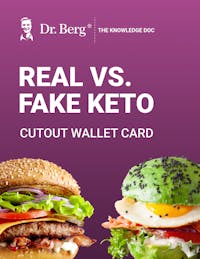
Keto vs. Non-Keto
Quickly compare keto-friendly foods with non-keto options for easy reference
Use this wallet card to make informed food choices while shopping or dining out
Identify fake keto foods and ingredients that you should avoid
Simplify decision-making with clear, practical guidelines

Keto vs. Non-Keto
Quickly compare keto-friendly foods with non-keto options for easy reference
Use this wallet card to make informed food choices while shopping or dining out
Identify fake keto foods and ingredients that you should avoid
Simplify decision-making with clear, practical guidelines

Keto vs. Non-Keto
Quickly compare keto-friendly foods with non-keto options for easy reference
Use this wallet card to make informed food choices while shopping or dining out
Identify fake keto foods and ingredients that you should avoid
Simplify decision-making with clear, practical guidelines

Keto vs. Non-Keto
Quickly compare keto-friendly foods with non-keto options for easy reference
Use this wallet card to make informed food choices while shopping or dining out
Identify fake keto foods and ingredients that you should avoid
Simplify decision-making with clear, practical guidelines

Keto vs. Non-Keto
Quickly compare keto-friendly foods with non-keto options for easy reference
Use this wallet card to make informed food choices while shopping or dining out
Identify fake keto foods and ingredients that you should avoid
Simplify decision-making with clear, practical guidelines

Keto vs. Non-Keto
Quickly compare keto-friendly foods with non-keto options for easy reference
Use this wallet card to make informed food choices while shopping or dining out
Identify fake keto foods and ingredients that you should avoid
Simplify decision-making with clear, practical guidelines

Keto vs. Non-Keto
Quickly compare keto-friendly foods with non-keto options for easy reference
Use this wallet card to make informed food choices while shopping or dining out
Identify fake keto foods and ingredients that you should avoid
Simplify decision-making with clear, practical guidelines

Keto vs. Non-Keto
Quickly compare keto-friendly foods with non-keto options for easy reference
Use this wallet card to make informed food choices while shopping or dining out
Identify fake keto foods and ingredients that you should avoid
Simplify decision-making with clear, practical guidelines

Keto vs. Non-Keto
Quickly compare keto-friendly foods with non-keto options for easy reference
Use this wallet card to make informed food choices while shopping or dining out
Identify fake keto foods and ingredients that you should avoid
Simplify decision-making with clear, practical guidelines

Keto vs. Non-Keto
Quickly compare keto-friendly foods with non-keto options for easy reference
Use this wallet card to make informed food choices while shopping or dining out
Identify fake keto foods and ingredients that you should avoid
Simplify decision-making with clear, practical guidelines

Keto vs. Non-Keto
Quickly compare keto-friendly foods with non-keto options for easy reference
Use this wallet card to make informed food choices while shopping or dining out
Identify fake keto foods and ingredients that you should avoid
Simplify decision-making with clear, practical guidelines

Keto vs. Non-Keto
Quickly compare keto-friendly foods with non-keto options for easy reference
Use this wallet card to make informed food choices while shopping or dining out
Identify fake keto foods and ingredients that you should avoid
Simplify decision-making with clear, practical guidelines

Keto vs. Non-Keto
Quickly compare keto-friendly foods with non-keto options for easy reference
Use this wallet card to make informed food choices while shopping or dining out
Identify fake keto foods and ingredients that you should avoid
Simplify decision-making with clear, practical guidelines

Keto vs. Non-Keto
Quickly compare keto-friendly foods with non-keto options for easy reference
Use this wallet card to make informed food choices while shopping or dining out
Identify fake keto foods and ingredients that you should avoid
Simplify decision-making with clear, practical guidelines

Keto vs. Non-Keto
Quickly compare keto-friendly foods with non-keto options for easy reference
Use this wallet card to make informed food choices while shopping or dining out
Identify fake keto foods and ingredients that you should avoid
Simplify decision-making with clear, practical guidelines
Kefir is low-carb and safe on a Healthy Keto™ diet. It has 10 to 13 grams of carbohydrates per serving, which fits within your daily carb limit on keto. Kefir is an incredible way to support gut health, sleep, and immune function—find out why!

What is keto?
Keto is a high-fat, moderate-protein, and low-carbohydrate diet that puts your body into a metabolic state called ketosis. When on a keto diet, your body uses ketones (dietary and body fat) as a fuel source rather than glucose (sugar).
Many believe fatty foods are unhealthy, but this is only true when combined with a high-carb diet. If you keep your carbohydrates low, your body will be forced to use energy from fat instead of carbs.
On a ketogenic diet, you limit your daily carbohydrates to 20 to 50 grams to stay in ketosis. This means you have to avoid high-carb foods, like bread, pasta, and cereal. This keto calculator will help you calculate how much you should eat.
What is kefir?
Kefir is a fermented drink made with dairy, coconut milk, or water. It’s usually fermented with yeasts and live bacteria called kefir grains. The word 'kefir' comes from the Turkish word ‘keyif’–meaning ''feel good after a meal.’’
This drink is often compared to yogurt because of its thick look and tangy taste. However, it’s a healthier option than yogurt because it’s loaded with friendly microbes (probiotics).
Kefir has about 12 to 15 strains of microbes, while yogurt has just 3 to 5. Yogurt is also pasteurized, which kills off most of the beneficial microbes.
Fermented foods—including kombucha tea, kimchi, sauerkraut, pickles, and miso—are rich in probiotics that help keep unhealthy bacteria under control.
Your body needs probiotics to support digestive health, nutrient absorption, normal inflammation levels, acid reflux, and immune system function. Friendly gut microbes even produce essential vitamins that your body can’t make on its own.
Speaking of healthy fats and dairy, cottage cheese is another excellent source of healthy fats and probiotics compared to yogurt.
Cottage cheese is often a great choice for people on the keto diet because it's high in protein and low in fat. But is cottage cheese keto? There are some carbs that can sneak up when you're not looking but, yes, cottage cheese is keto-friendly so if your looking for a healthy "cheese" dish cottage cheese is a great choice.

Kefir nutritional facts
The nutritional content of kefir depends on the drink used to prepare it—it can be made with dairy milk, coconut milk, or water. Plain organic grass-fed kefir provides the most health benefits because it contains a wider variety of friendly bacteria than other fermented foods.
Take a look at the nutritional values of kefir compared to other fermented foods.
Plain, whole milk kefir (1 cup):
Calories: 161
Protein: 9 grams
Fat: 2 grams
Net carbs: 10 grams
Fiber: 0 grams
Minerals: calcium, sodium
Vitamins: vitamin A, vitamin D
CFU: 27 billion
Plain, whole milk yogurt (1 cup):
Calories: 138
Protein: 7.8 grams
Fat: 8 grams
Net carbs: 11 grams
Fiber: 0 grams
Minerals: calcium, phosphorous, sodium
Vitamins: riboflavin
CFU: 3.6 billion
Regular kombucha (1 cup)
Calories: 30
Protein: 0 grams
Fat: 0 grams
Net carbs: 7 grams
Fiber: 0 grams
Minerals: potassium, manganese, fluoride ions
Vitamins: thiamine, riboflavin, niacin, folate, B6 and B12
CFU: 3.6 billion
Kimchi (1 cup)
Calories: 23
Protein: 1 gram
Fat: 0 grams
Net carbs: 4 grams
Fiber: 2 grams
Minerals: potassium, calcium, iron, magnesium
Vitamins: vitamin A, vitamin B6, vitamin C, folate
CFU: 5 billion
Sauerkraut (1 cup)
Calories: 27
Protein: 1.3 grams
Fat: 0 grams
Net carbs: 6 grams
Fiber: 4 grams
Minerals: potassium, calcium,
Vitamins: vitamin A, vitamin C, vitamin K, folate
CFU: 3 billion
Can you have kefir on the Healthy Keto diet?
Kefir is safe to have on a Healthy Keto diet, but you have to be careful not to go over your daily carb limit. One cup of whole-milk kefir contains 10 to 13 grams of carbs—so stick to one serving per day.
You can also try water kefir, which has fewer carbs than whole milk and coconut milk varieties. One serving of water kefir typically contains less than one gram of carbs.
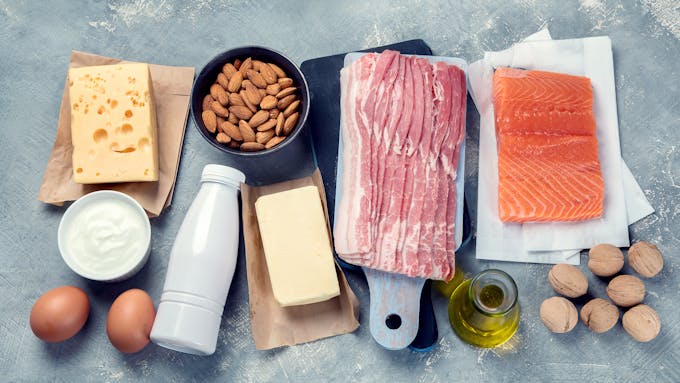
Health benefits of kefir
Supports gut health and digestion
Kefir is rich in live microbes that improve your gut health. The natural probiotics in kefir help prevent the overgrowth of unfriendly microbes and increase the variety and concentration of friendly microbes.
Diverse gut flora promotes healthy digestion, reduces bloating, protects against pathogens, boosts immune function, and supports metabolic health.
Reduces liver fat
The liver produces bile, which helps you break down fat. When your bile is low, fat can accumulate in your liver. This often causes nausea, cravings, pale or floating stool, and bloating after consuming fatty foods.
Probiotics change gut microbiota composition and increase bile acid synthesis, which can help reduce liver fat. Kefir is one of the best natural probiotics for balancing your microbiome and keeping your colon clean and healthy.
Promotes quality sleep
A half a cup of kefir in the evening can significantly increase your sleep quality and duration.
Kefir contains microbes that produce serotonin—a feel-good hormone that affects your mood and reduces stress. It also makes melatonin, which controls sleep.
Many other nutrients in kefir also promote sleep, including calcium and thiamine.
Supports immune function
Kefir is rich in friendly microorganisms that modulate your immune system.
One report on the health benefits of kefir for immune system function shows that it enhances the immune response by increasing cytokine production. It also has potent anti-inflammatory properties.
Safe for those with lactose intolerance
Lactose intolerance is when your body can’t break down and digest lactose properly because you lack the enzyme lactase. This can cause gas, bloating, diarrhea, nausea, and cramps when you consume most dairy products.
Kefir is safe for most people with lactose intolerance because it’s extremely low in lactose compared to other dairy products. The lactic acid bacteria in kefir convert lactose into lactic acid during the fermentation process.
How to make keto kefir
You can make keto-friendly kefir at home out of coconut milk, full-fat milk, or water. Learn how to prepare each of them!
Coconut milk keto-friendly kefir recipe
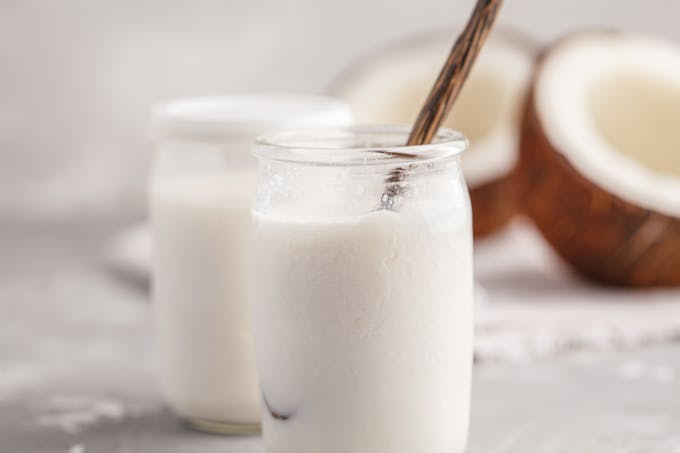
Time: 1 to 2 days
Servings: 8
Per serving (½ cup): 223 calories, 2.3 g protein, 1.9 g carbohydrates, 24.1 g fat
Ingredients
4 cups coconut milk
1 kefir sachet starter
Directions
Mix coconut milk and kefir sachet starter together until they combine.
Pour the mixture into a large jar and cover it loosely with cheesecloth or a clean kitchen towel.
Leave it at room temperature (72 to 86 degrees F / 22 to 30 degrees C) for 24 to 48 hours.
Strain out the kefir grains and pour milk kefir into an air-tight container.
Shake well and enjoy!
Store leftover coconut milk kefir in the fridge for up to 30 days.
Tip: Add low-carb sweeteners like stevia or sucralose to add sweetness, or add vanilla extract, cocoa, or cinnamon powder for a boost of flavor.
Full-fat milk keto-friendly kefir recipe
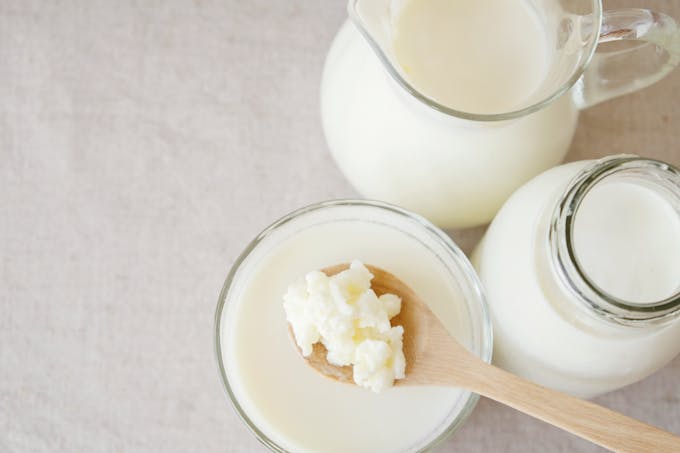
Time: 3 days
Servings: 1
Per serving (1 cup): 154 calories, 9 g protein, 7 g carbohydrates, 8 g fat
Ingredients
1 Tbsp kefir grains
1 cup full-fat milk
Directions
1. Put kefir grains into a glass container. Pour the milk over them and stir to combine.
2. Cover the mixture loosely with cheesecloth or a clean kitchen towel.
3. Leave it to ferment at room temperature (72 to 86 degrees F / 22 to 30 degrees C) for 12 to 36 hours. The fermentation process is done when it smells sour and the consistency is slightly thick throughout. You may also notice the whey separate from the milk.
4. Strain out the kefir grains and pour milk kefir into an air-tight container.
4. Shake well and enjoy!
5. Store leftover milk kefir in the fridge for up to 30 days.
Tips: Avoid warming or heating the kefir so that you don’t kill the microorganisms—cold kefir would do better.
Keto-friendly water kefir recipe
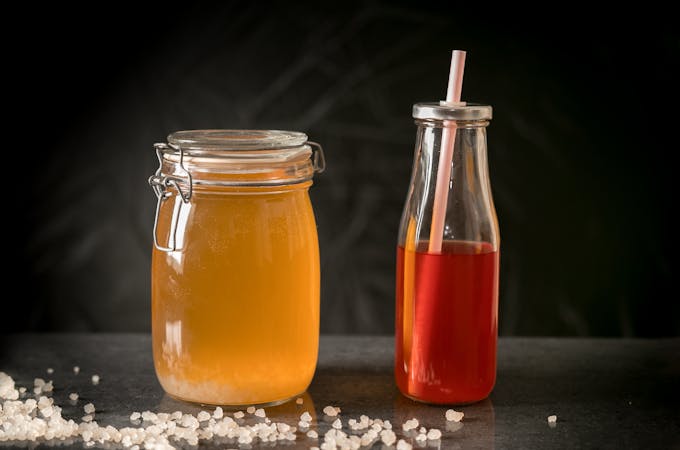
Time: 2 to 3 days
Servings: 2
Per serving (1 cup): 10 calories, 2 g protein, 2 g carbohydrates, 0 g fat
Ingredients
¼ cup sugar (organic)
2 cups chlorine-free water
2 Tbsp kefir grains
Directions
1. Add sugar and chlorine-free water to a jar and stir thoroughly.
2. Add kefir grains to the sugar water mixture and cover the jar loosely with cheesecloth or a clean kitchen towel.
3. Allow it to ferment at room temperature (72 to 86 degrees F / 22 to 30 degrees C) for 2 to 3 days.
4. Strain out the kefir grains and pour water kefir into an air-tight container.
5. Shake well and enjoy!
6. Store leftover water kefir in the fridge for up to 30 days.
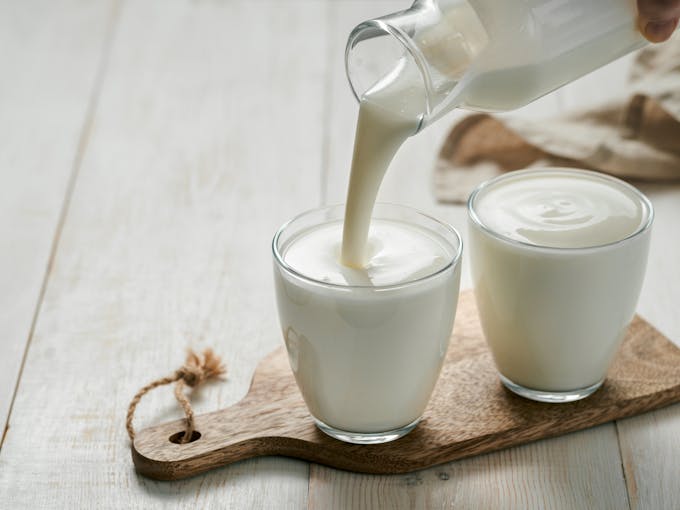
Key takeaways
Kefir is low-carb, keto-friendly, and rich in powerful probiotics that help support a healthy gut. It’s a healthier option than yogurt because it has a wider variety of friendly microbes.
While water kefir has the fewest carbs, coconut milk and full-fat milk are also relatively low in carbohydrates. Stick to one to two servings of milk kefir so you don’t go over your daily carb limit.
Always check the labels on store-bought kefir to avoid hidden sugar and unhealthy additives. Better yet, make your own! You can make homemade kefir with just a few ingredients and a little patience.
Find out how to make a delicious keto-friendly kefir drink that will melt away liver fat here.
FAQs
1. How many carbs are in kefir?
Plain, whole-milk kefir contains 9 to 13 grams of carbs.
2. What brands of kefir are keto-friendly?
Most kefir brands are naturally low-carb, which makes them safe on keto. Avoid brands that add sugar and preservatives.
3. Can I have kefir on a ketogenic diet?
Yes, you can have kefir on a low-carb diet. Kefir contains just 9 to 13 grams of carbohydrates per serving, which can fit within your daily carb limit.
4. Kefir vs. yogurt—which is better?
Kefir is better than yogurt because it contains more friendly microorganisms that provide incredible health benefits.
5. Does kefir contain friendly bacteria?
Yes, kefir is a fermented beverage that contains many friendly microbes. It has about 27 billion CFU (colony-forming units) per serving.
6. What is water kefir?
Water kefir is a fermented beverage made with water, kefir grains, and sugar. It has a fizzy texture, like soda, and it’s very low in carbs.
7. Is water kefir keto-friendly?
Yes, water kefir is safe to have on a ketogenic diet because it has a low carb content. One serving has just 0.6 to 1 gram of carbs. Avoid water kefir with added sugars.
8. Is kefir gluten-free?
Yes, kefir is gluten-free. It's made with live cultures and milk, coconut milk, or water—all of which contain zero gluten.
9. How long does it take to make homemade keto-friendly kefir?
Preparing homemade kefir takes one to three days, depending on the environmental temperature and method. The fermentation process is slower at temperatures below 72 degrees F / 22 degrees C.
10. What are the best ways to have kefir on keto?
Homemade smoothies and shakes are some of the best ways to have kefir on keto. Try this keto kefir shake recipe!
11. Can I have kefir if I’m lactose intolerant?
Yes. Kefir is not lactose-free because it’s made with fermented milk, but it’s still very low in lactose. The fermentation process converts lactose into lactic acid.
Previous blog
How To Fix A Slow Metabolism: MUST WATCH!
Popular
08/21/2024
55K views
02/23/2025
46.3K views
11/18/2024
277.5K views
03/18/2024
11/21/2022




